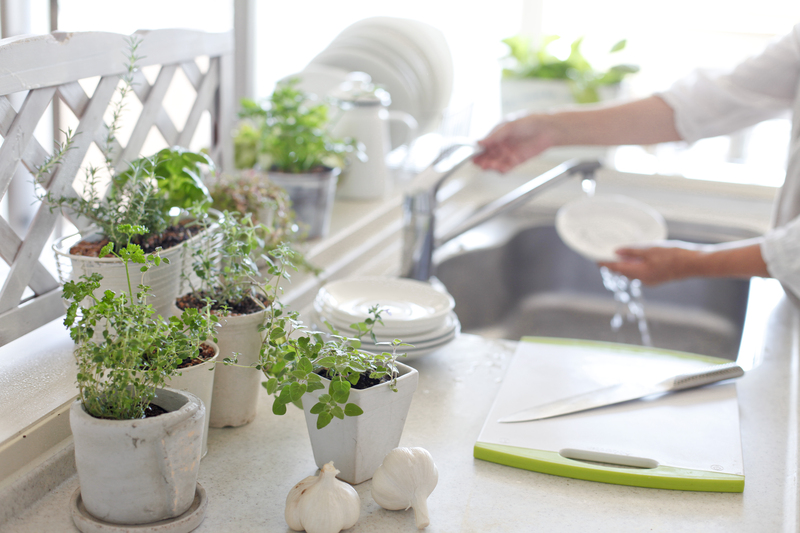From Seeds to Table: Growing Your Herb Garden
Posted on 24/05/2025
From Seeds to Table: Growing Your Herb Garden
If you have ever dreamed of snipping fresh basil for your pasta or garnishing a salad with home-grown parsley, cultivating your own herb garden is an engaging and satisfying experience. Whether you have sprawling outdoor space or a tiny kitchen windowsill, growing culinary herbs from seeds to table is rewarding, sustainable, and surprisingly simple. In this comprehensive guide, we will explore everything you need to know to grow your own herb garden, from seed selection and germination to harvesting and using your delicious herbs.
Why Grow Your Own Herbs?
- Freshness and Flavor: Nothing compares to the vibrancy of herbs freshly picked from your garden.
- Cost Effective: A packet of seeds can provide dozens of plants for the price of a single store-bought bunch.
- Health Benefits: Homegrown herbs are free from chemicals and pesticides, boosting both flavor and nutrition.
- Eco-Friendly: Reduce your carbon footprint by eliminating the need for plastic packaging or transportation.
- Therapeutic Value: Gardening relieves stress and fosters a closer connection with nature.

Choosing the Right Herbs for Your Garden
Picking the right varieties is the first critical step on your "seeds to table" herb gardening journey. Here are some easy and popular options to start with:
- Basil: A kitchen staple, perfect for Italian dishes and salads.
- Parsley: Versatile and hardy, ideal for garnishing and flavoring.
- Chives: Quick-growing, great for soups and dips.
- Mint: Excellent for teas and desserts--plant in a pot to prevent spreading.
- Cilantro (Coriander): Essential in Latin American and Asian cuisines.
- Oregano: Perfect for Mediterranean and Mexican dishes.
- Rosemary: Woody herb, ideal for roasting meats and vegetables.
- Thyme: Compact and fragrant, used in a variety of recipes.
Annual Vs. Perennial Herbs
Annual herbs complete their life cycle in one growing season (such as basil and cilantro), while perennial herbs (like rosemary, thyme, and chives) live for several years with the right care. Mixing both varieties ensures a year-round supply of fresh herbs.
Planning Your Herb Garden
Before planting your edible garden, consider space, sunlight, and accessibility. Herbs can be grown in the ground, raised beds, pots, or even indoors. Here are key points for a successful plan:
- Sunlight: Most herbs need at least 6 hours of direct sunlight daily.
- Soil: Well-draining soil rich in organic matter is best for herb growth.
- Accessibility: Place your garden near your kitchen or a patio for easy harvesting.
- Water Source: Make sure your plants are close to a water supply for ease of care.
Container Gardening: If outdoor space is limited, herbs thrive in containers placed on windowsills, balconies, or patios.
Companion Planting with Herbs
Certain herbs support each other's growth and help deter pests naturally. For instance, basil and tomatoes grow well together, while mint is best isolated in pots due to its aggressive spreading.
Starting Your Herb Garden from Seeds
Growing herbs from seeds is both economical and rewarding. Follow these simple steps for success:
1. Choosing Quality Herb Seeds
Purchase fresh, organic, and untreated seeds from reputable sources. Verify germination rates and expiration dates to enhance success.
2. Seed Starting Mix and Containers
- Use sterile, well-draining seed starting mix.
- Seed trays, peat pots, egg cartons, or small containers with drainage holes work well.
3. Planting the Seeds
- Moisten the seed mix before planting.
- Sow seeds according to specific depth instructions on the packet (usually 1/8 to 1/4 inch deep).
- Cover lightly with soil and mist with water.
4. Providing the Right Conditions
- Maintain warm temperatures (65-75?F).
- Keep the soil consistently moist but not waterlogged.
- Cover with a clear lid or plastic wrap to hold in moisture until seeds germinate.
5. Light for Seedlings
- Place seedlings near a bright window or use grow lights if needed.
- Rotate containers regularly to encourage even growth and prevent legginess.
6. Thinning and Transplanting
- Once seedlings develop two sets of true leaves, thin them out by snipping weaker plants at soil level.
- Transplant young plants outdoors or into larger containers when they are 3-4 inches tall and after the danger of frost has passed.
Soil Preparation and Planting
Preparing Outdoor Beds
- Loosen the Soil: Dig down at least 8-10 inches and remove weeds or debris.
- Add Compost: Mix in 2-3 inches of organic compost for nutrients and drainage.
- Level and Water: Smooth the soil and lightly water before planting.
Plant Spacing and Arrangement
- Avoid crowding: Follow recommended spacing--usually 8-12 inches apart--so herbs can develop fully.
- Height matters: Place taller herbs (like fennel or dill) at the back or center, and low growers (like thyme or chives) toward the front.
Caring for Your Herb Plants
Watering
- Water deeply but allow soil to dry slightly between watering. Herbs do not like wet feet!
- Container plants may need more frequent watering, especially in summer.
Feeding
Feed herbs every 4-6 weeks with a balanced, organic fertilizer or diluted liquid seaweed. Avoid over-fertilizing, as this can reduce flavor and aroma.
Pruning and Pinching
- Regularly pinch back growing tips to encourage bushy growth and prevent flowering (which can make leaves bitter).
- Harvest herbs often for freshest taste and continual regrowth.
Mulching and Weeding
- Add a layer of organic mulch to conserve moisture, suppress weeds, and regulate soil temperature.
- Remove weeds promptly to prevent competition for light and nutrients.
Pest and Disease Management
- Inspect plants regularly for aphids, snails, and fungal diseases.
- Handpick pests or rinse off with a strong spray of water.
- Encourage beneficial insects like ladybugs or use organic neem oil if needed.
Harvesting Your Homegrown Herbs
The moment you've been waiting for arrives: kitchen-fresh herbs ready to enjoy!
- Harvest in the morning, after dew has dried but before heat wilts the leaves.
- Only take no more than one-third of the plant at a time to allow regrowth.
- Use sharp scissors or snips to prevent tearing the stems.
- For perennial herbs, stop harvesting several weeks before the first frost to allow hardening for winter.
Best Practices for Each Herb
- Basil: Pinch off flowers and snip above a set of leaves to promote bushiness.
- Parsley: Cut outer stems at soil level, leaving the center to produce new leaves.
- Thyme and Oregano: Harvest stems before flowering for the most intense flavor.
- Mint: Trim stems regularly to keep the plant bushy and prevent flowering.
Preserving and Using Your Herbs
If your herb garden is extra productive, learn to preserve herbs for year-round culinary inspiration. Here are popular methods:
Drying Herbs
- Bunch stems together and hang upside down in a dry, dark, well-ventilated area.
- Once crispy, crumble leaves and store in airtight jars away from sunlight.
Freezing Herbs
- Chop herbs and freeze in ice cube trays with water or olive oil. Pop out cubes as needed for recipes.
- Whole leaves (like basil or parsley) can be laid flat on baking sheets and frozen before transferring to sealed bags.
Infusing and Flavoring
- Create herb-infused oils or vinegars for salads, marinades, and dipping sauces.
- Herb butters and pastes are delicious ways to preserve flavor.
From Garden to Plate: Culinary Ideas
- Basil: Classic pesto, Caprese salad, pizza toppings.
- Mint: Mojitos, tea, desserts, and chutney.
- Rosemary: Roasted meats, potatoes, bread, and infused syrups.
- Chives: Scrambled eggs, baked potatoes, soups, and dips.
- Cilantro: Salsas, curries, tacos, and chutneys.
- Oregano and Thyme: Slow-simmered sauces, Mediterranean dishes, and grilling marinades.
Troubleshooting Your Herb Garden
- Leggy seedlings? Increase light exposure and ensure seedlings aren't crowded.
- Yellow leaves? Overwatering or poor drainage could be to blame--check pots and soil moistness.
- No growth? Examine soil fertility and sun exposure; move containers if necessary.
- Wilting herbs? Check if you are underwatering or watering too much. Adjust accordingly.
- Herbs going to seed too soon? Pinch off flower buds to extend leaf production.

Inspiring Herb Garden Layouts
Create a unique herb garden design that complements your home and lifestyle. Try these creative layouts:
- Herb Spiral: A space-efficient, attractive spiral-shaped bed that optimizes sun and drainage.
- Kitchen Windowsill Garden: Potted herbs on a bright sill--ideal for apartment dwellers.
- Vertical Herb Wall: Use vertical planters or repurposed pallets to grow herbs on fences or walls.
- Raised Beds: Easy to maintain and perfect for a mix of herbs in small yards.
- Traditional Row Garden: Suitable for a larger space and diverse varieties.
Conclusion: Savor the Rewards from Seeds to Table
Growing your own herb garden, from seeds to table, is a journey filled with flavor, fragrances, and fulfillment. By selecting the right herbs, nurturing them through each stage, and harvesting at their peak, you can enjoy an endless supply of the freshest culinary additions to your meals. Whether your garden is a small pot or a sprawling outdoor haven, the satisfaction of homegrown herbs elevates both your cooking and your connection to nature. Start your herb garden today and experience the unbeatable taste of freshness, right from your own table!
Frequently Asked Questions About Herb Gardening
- How long do herbs take to grow from seed? Most common herbs sprout in 7-21 days and can be harvested in 1-3 months, depending on the variety and conditions.
- Can I grow herbs indoors all year round? Yes, with adequate light and warmth, many herbs thrive on sunny windowsills indoors throughout the year.
- Which herbs grow well together? Try parsley, cilantro, basil, and chives together. Keep aggressive growers like mint and lemon balm in separate pots.
- Do herbs need special soil? Use well-draining, nutrient-rich soil. Adding compost improves results and flavor.
- What if I don't have a garden? Herbs thrive in containers--get creative with pots, window boxes, or vertical planters!
Ready to get started? Plant your first seeds now and enjoy the journey from garden to gourmet, one sprig at a time!





